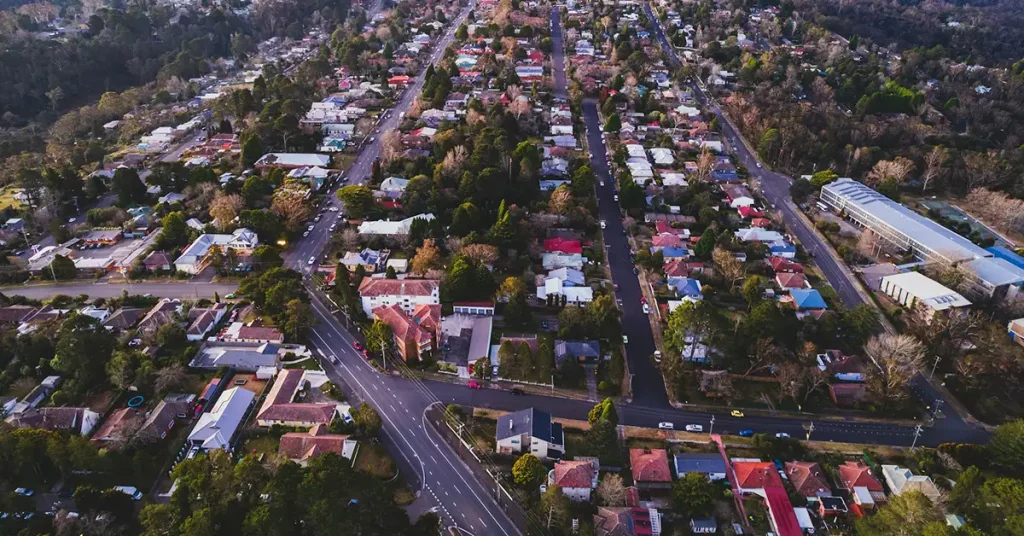Expected to deliver 112,000 homes across NSW over the next five years, the State Environmental Planning Policy (Housing) 2021 has been divided into two stages. Released in 2024, Stage 1 focuses on changing the permissions for dual occupancies and semi-detached homes. Stage 2, the NSW Low and Mid-Rise Housing Policy was introduced in February 2025 and establishes new planning controls in nominated town centres.
Understanding the NSW Housing Policy Changes
The NSW Low and Mid-Rise Housing Policy, effective from February 28, 2025, targets the “missing middle” housing types that fill the gap between detached homes and high-rise apartments. It permits the development of dual occupancies, terraces, townhouses, and residential flat buildings within 800 metres of 171 town centres and transport hubs in NSW.
Covering areas across metropolitan Sydney, the Central Coast, Illawarra-Shoalhaven, and Hunter regions, the policy will contribute to the state’s target of 377,000 new homes by 2029 under the National Housing Accord.
By focusing development in areas with access to public transport, shops, and services, the policy promotes sustainable living and aims to reduce reliance on private vehicles. It aims to offer diverse housing options like low-rise (1-2 storeys) and mid-rise (3-6 storeys) buildings to meet varied lifestyle needs.
The policy’s emphasis on density near transport hubs aligns with transport planning goals but introduces both short-term challenges and long-term benefits for traffic management.
Transport Challenges
In the short-term, increased housing density will likely lead to higher traffic volumes on local roads, particularly during peak hours and construction phases. This could strain existing road networks, especially in areas where infrastructure hasn’t been upgraded to handle additional demand.
People tend to have clear expectations about the operations of the roads. In short, the consensus is that congestion equals a bad outcome; it means that something went wrong and needs to be fixed.
Governments can and have been leveraging the ‘congestion is bad’ model by continuing to invest in road projects to provide the base capacity for moving people around. However, the space for roads is finite and eventually this model breaks down.
Increasing density in established town centres is to accept that it will be harder to use private vehicles as a primary transport mode. It requires truly embracing public transport (with some micro / active mobility) as the main solution to move large numbers of people efficiently and sustainably compared to individuals in their private cars.
The NSW Low and Mid-Rise Housing Policy will inevitably trigger concerns about congestion. Local communities and, most significantly, relevant authorities will need to change their attitudes towards congestion levels.
It is known that people tend to choose their transport mode based on three factors: time, cost and convenience. A private vehicle will usually win in terms of time and convenience.
Therefore, one way to increase adoption of public transportation is to make it harder to drive. To achieve that, many strategies can be used, but that will only be possible if authorities change their threshold for intersection performance. Otherwise, proposed developments under this new policy risk failing to meet traffic performance requirements necessary for development approval.
Investing in public transport networks is obviously required to support transport mode change in the long term and enable the high-density model to be implemented. Long term investments such as the light rail and the new metro have significant impact, but short-term improvements can also be an ally of this change.
Strategies to Support High-Density Areas:
- Placemaking: Urban designs that prioritise pedestrians over cars (i.e., larger footpaths instead of more on-street parking) to foster walkable communities. This includes creating public spaces for social interaction, creating destinations, reducing the need for short car trips.
- Intersection Performance Thresholds: Authorities may need to redefine acceptable intersection performance levels to accommodate increased traffic without labelling it as problematic congestion. Adaptive traffic signal systems that adjust in real-time to traffic conditions can optimise flow and reduce delays.
- Active Transport Promotion: Designing neighbourhoods with safe, connected pedestrian and cycle paths encourages non-car travel. Prioritising pedestrian call-ups at traffic signals and creating vibrant streetscapes can transform car-centric environments into people-centric spaces.
- Technology Upgrades: Modern traffic management technologies, such as intelligent traffic lights and real-time monitoring, can improve efficiency. Replacing in-road loops with advanced detectors and sensors provides accurate data for signal control, while adaptive signal systems shorten phases when vehicle gaps increase.
- Traffic Signal Coordination: Reviewing signal coordination, especially during off-peak periods, allows intersections to operate based on current conditions rather than fixed timings, improving flexibility and reducing unnecessary delays.
- Public Transport Investment: In the long term, expanding public transport infrastructure, such as metro, light rail, and bus networks, is critical to support denser populations. Enhanced services ensure residents have reliable alternatives to driving, reducing road congestion.
Some of these strategies are being explored by Transport for NSW through initiatives like the intelligent traffic light program, which tests advanced traffic management technologies to enhance urban mobility.
Will the new policy be successful?
The NSW Low and Mid-Rise Housing Policy offers an additional path towards increasing housing supply by promoting the development of diverse, well-located homes. However, its success depends on a series of factors including robust traffic engineering and transport planning strategies. From this perspective, the goal should be managing short-term traffic increases and supporting a long-term shift towards public and active transportation. By investing in public and active transport infrastructure and smart traffic management technologies, NSW can create denser, more liveable communities with reduced reliance on private vehicles.
Watch these videos for a quick summary on this topic:

